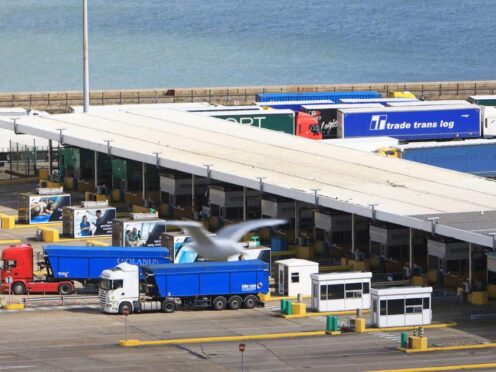The Government has no clear timetable to fully implement its post-Brexit border controls with the EU, the National Audit Office (NAO) said on Monday.
The UK has said it hopes to have the “world’s most effective border” by 2025, but the NAO said the strategy “lacks a clear timetable and an integrated cross-government delivery plan”, with individual departments responsible for implementing different aspects.
It also said that repeated changes to and deferrals of the plan to introduce full import controls have led to uncertainty for businesses and extra costs for government and ports.
The public spending watchdog said that since the transition period concluded at the end of 2020, the Government has delayed its plans five times and spent money on infrastructure and staff that were ultimately not needed.
The Government estimates the overall cost of implementing new arrangements and improving the management of the border to be £4.7 billion, according to NAO.
Gareth Davies, head of the NAO, said: “The UK leaving the EU created a large-scale change in arrangements for the movement of goods across the border. However, more than three years after the end of the transition period, it is still not clear when full controls will be in place.
“The border strategy has ambitious plans to use technology and data to facilitate trade while managing risks. To achieve its objectives, Government requires strong delivery and accountability – including a more realistic approach to digital transformation – together with effective monitoring to enable future improvements.”
The first of the Government’s promised annual progress reports for the strategy, published in 2020, will not come until 2025 at the earliest, the watchdog said.
A partial import control regime is currently in place. The Government intends to introduce most of the remaining import controls during 2024 but it is still not clear when full controls will be in place.
The report noted that border processes, including the introduction of full customs controls, have largely operated smoothly since the UK’s exit from the EU, but said that businesses trading goods between the UK and the EU have faced additional costs and administrative burdens.
Late announcements about policy and uncertainty about the implementation of controls have also meant businesses and ports have been less able to prepare for changes, it said.
It notes that the UK Government is still finalising its plans for the movement of goods into and out of Northern Ireland.
Martin McTague, national chair of the Federation of Small Businesses, said that the group’s research shows almost one in 10 small firms that used to export or import goods have stopped doing so in the past five years, in part due to the volume of paperwork, costs and supply chain or logistical issues.
He said: “New border processes have been worryingly complex and costly for SMEs. A lack of co-ordinated policy approach has led to confusion – and it’s right that these challenges have been highlighted in the NAO report.”
He added: “With more changes on the horizon it’s crucial that small businesses are able to plan ahead. They need clarity and certainly don’t have time to unravel confusing messages from a variety of different Whitehall departments. The Government should communicate with SMEs with a single voice, setting out clear and realistic timescales for any future changes.
“Government needs to ensure that changes are better planned, timetabled and tested to ensure that operations run smoothly. This will minimise damage to trade and indeed our international global reputation.”
